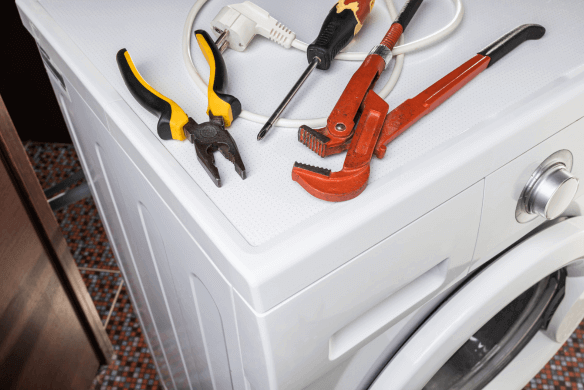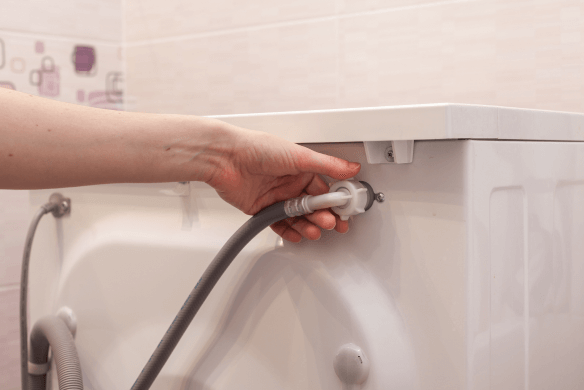If your appliances are being removed or you’re moving house, you’ll need to disconnect them first. Thankfully, the steps in this guide should make it easy. You’ll just need a few basic tools and maybe someone to help you pull the appliance away from the wall.
Are you a Domestic & General customer who’s ordered a replacement product? Find out more about when you need to disconnect your old product in our FAQs.
Now let’s find out how to disconnect your washing machine and appliances like your fridge, dishwasher or tumble dryer.
Prefer to watch?
Safety first
Before you do anything else, switch the appliance off and unplug it from the wall.
It’s important to check the appliance’s manual for any specific guidelines before you start.
Washing machines are heavy, so be careful not to strain yourself when pulling yours away from the wall. You always need at least two people to move an appliance up or down stairs or load it into a vehicle.
Tools you’ll need

There are no specialist tools for this. All you might need is:
- Adjustable pliers
- A screwdriver (Phillips head, usually)
- Waterproof gloves
- A couple of buckets
- Towels or cloths
These items will help you disconnect the hoses and catch any water before it goes all over the floor.
How to disconnect your washing machine
Knowing how to disconnect your washing machine can save time and money when preparing for a repair because you don't need to pay someone else to do it. So it’s a useful skill to have, and if you’ve got a pair of pliers, you shouldn’t find it hard.
1. Turn off the power
Before anything else, switch the washing machine off and unplug it at the wall. If the plug socket can’t be reached, turn off the water and move the machine first — see steps two and three.
2. Turn off the water supply
Sometimes there is one valve that shuts off all water to the appliance, like the valve behind a toilet. If you have this setup, it’s easy to shut off the water to the machine by closing that valve.
Otherwise, you’ll need to turn off the two water connection valves or stopcocks. These might be under the kitchen sink or in a box attached to the wall.
Finally, if you can’t turn off those connections you can still turn off the mains water supply. You can usually find the house’s main stop valve under the kitchen sink. Or check your airing cupboard, under the stairs or floorboards, near the front door, or the garage, utility room, bathroom or cellar.
3. Pull the machine out
If you feel strong enough to pull the washing machine out by yourself, you shouldn’t have any problems.
Some machines have wheels, which make them easier to move. If the machine has feet, you can slip some thick cardboard or carpet underneath to avoid scratching the floor.
When you’re ready, open the washing machine’s door, put your hands in and hold on to the top edge. Use this grip to pull the machine towards you little by little. If this isn’t working, you can grab one side, pull it forward and then repeat on the other side.
You just need to pull the machine far enough out to disconnect the hoses. An angle of 45 or 90 degrees from the wall might be enough, depending on what’s around.
4. Disconnect the hoses

Now you need your buckets and towels. Put one bucket at each end of the water pipes, to catch anything that spills out. Then put some towels on the floor where water is likely to go.
Next, use your adjustable pliers or wrench to unscrew the water pipes on the back of the machine. Put each pipe in a bucket and hold the pipes up to get all the water out.
Last, you need to pull the drain pipe or hose out of the outlet pipe. This is most often next to the water supply pipe. Hold the drain pipe over the bucket until it’s completely empty.
That’s it — your washing machine is now disconnected and ready to move.
How to disconnect other kitchen appliances
You can disconnect appliances like fridges, dishwashers and tumble dryers in a similar way to a washing machine.
Gas appliances are different, though — you can’t disconnect them yourself. For safety, you must use a Gas Safe registered engineer.
Fridges and freezers
Disconnecting a fridge or freezer is usually as simple as unplugging it. If your model has an ice maker or cold water dispenser, you’ll also need to disconnect that. Follow the same steps as for disconnecting a washing machine hose.
If you’ve asked us to recycle your old freezer, you’ll need to defrost and empty it first. Check out our guide on how to defrost a freezer safely.
Tumble dryers
Tumble dryers have either a waste water hose or a vent tube. In both cases you’ll need to disconnect them before getting a repair.
For a plumbed dryer, disconnecting the water hose is the same as doing this for a washing machine’s hose.
Vented dryers are different, because they often have metal clamps that hold the vent tube in place. These usually have a screw which you can undo with a flat head screwdriver. Then the vent tube should just slip off the connections.
Our blog is loaded with more related articles

Washing machine tips
How to clean your washing machine
Regular cleaning of your washing machine is important to keep it running smoothly. Find out how to clean your washing machine,...
Read more

Washing machine tips
How to extend the lifespan of your washing machine
The humble washing machine is the workhorse of a household. By following some simple hints and tricks you could add a few more...
Read more

Washing machine tips
How to use a washing machine: a step-by-step guide
Washing machines are essential appliances but they can be confusing to use. Read our guide on how to use a washing machine to g...
Read more
